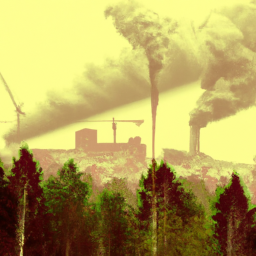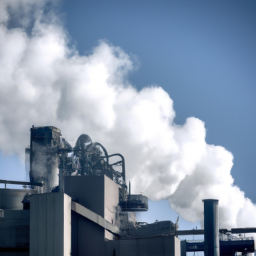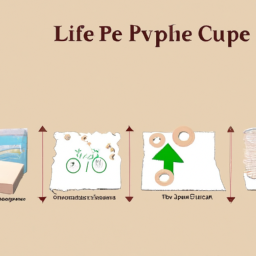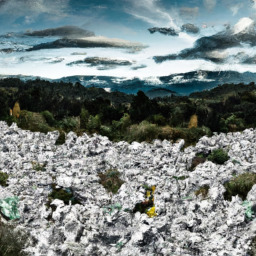Are you wondering if paper is truly eco-friendly? This article explores the environmental impact of paper production, from deforestation to energy consumption and water pollution. We’ll also delve into the life cycle of paper, examining recycling efforts and the alarming amount of paper waste in landfills. In addition, we’ll discuss alternatives such as digitalization and e-books, and explore sustainable practices in paper consumption. By providing unbiased evidence-based information, this article aims to help you make informed choices about your use of paper.
Environmental Impact of Paper Production

The environmental impact of paper production isn’t always considered when we use paper products. Paper production contributes to deforestation consequences and has a significant carbon footprint that needs to be addressed for sustainable practices. Deforestation occurs when trees are cut down to make way for paper mills or timber harvesting. This leads to the loss of vital habitats, biodiversity, and disrupts the delicate balance of ecosystems. Additionally, deforestation contributes to climate change as trees absorb carbon dioxide from the atmosphere, helping reduce greenhouse gas emissions.
Reducing the carbon footprint of paper production is crucial in mitigating its environmental impact. One way to achieve this is through sustainable forest management practices such as reforestation and afforestation programs. These initiatives aim to replenish forests by planting new trees and restoring degraded areas, ensuring a continuous supply of timber without causing further deforestation. Another approach is promoting recycling and reducing paper consumption through digital alternatives like e-books or online documents.
Deforestation and Paper Manufacturing

You can’t deny that deforestation and the process of manufacturing paper have a significant impact on the environment. Deforestation, which refers to the clearing of forests for various purposes, including paper production, leads to numerous consequences. One major consequence is the loss of biodiversity as many plant and animal species lose their natural habitat. Additionally, deforestation contributes to climate change by releasing large amounts of carbon dioxide into the atmosphere.
However, it’s important to note that not all paper manufacturing practices contribute equally to deforestation and its consequences. Sustainable forestry practices play a crucial role in mitigating these impacts. These practices involve responsibly managing forests by replanting trees after harvesting them for paper production and ensuring that logging activities do not exceed sustainable levels.
Moreover, sustainable forestry certifications such as Forest Stewardship Council (FSC) certification provide assurance that wood used in paper production comes from responsibly managed forests. By supporting companies that use sustainably sourced materials and promoting recycling initiatives, individuals can contribute towards reducing the environmental impact of paper manufacturing.
Energy Consumption in Paper Mills

To reduce energy consumption in paper mills, it’s important to implement efficient machinery and utilize renewable energy sources. Energy efficiency measures can significantly reduce the environmental impact of paper production. By investing in state-of-the-art equipment, such as high-efficiency boilers and advanced heat recovery systems, paper mills can minimize energy waste and optimize their operations.
One effective way to achieve energy efficiency is by utilizing renewable energy sources. Many paper mills are now incorporating solar panels or wind turbines into their facilities. These renewable sources provide a clean and sustainable option for generating electricity, reducing reliance on fossil fuels.
In addition to renewable energy, paper mills can also implement other strategies to increase energy efficiency. For example, optimizing the production process through better control systems can help reduce unnecessary energy consumption. Installing efficient lighting systems and implementing insulation techniques can further contribute to significant energy savings.
Several studies have shown that these measures not only benefit the environment but also result in financial savings for paper mills. By cutting down on energy consumption, companies can lower their operating costs in the long run.
Water Usage and Pollution in the Paper Industry

Water usage and pollution in the paper industry can be reduced by implementing efficient water recycling systems and minimizing the release of harmful chemicals into water sources. Water conservation is a crucial aspect of sustainable paper production. By adopting efficient water recycling systems, paper mills can minimize their dependence on freshwater sources and reduce overall water consumption. These systems involve treating wastewater through a series of processes that remove impurities and contaminants, making it suitable for reuse within the facility. Additionally, implementing measures to minimize the release of harmful chemicals into water sources is essential for protecting both human health and the environment. This can be achieved through proper waste management practices, such as using closed-loop systems to contain and treat chemical-laden wastewater before discharge. Furthermore, investing in advanced technologies like biological treatment processes can significantly improve the efficiency of wastewater treatment while reducing pollution levels. Overall, by prioritizing water conservation and implementing effective wastewater treatment measures, the paper industry can make significant strides towards reducing its environmental impact in terms of water usage and pollution.
Recycling and the Life Cycle of Paper

When recycling paper, it’s important to separate it from other types of waste to ensure it can be properly processed and reused. Recycling paper offers numerous benefits, including reducing the demand for new raw materials, conserving energy and water, and minimizing landfill space. By recycling one ton of paper, you can save around 17 trees and reduce carbon emissions by approximately 1.5 metric tons. The process of recycling paper involves several steps: collection, sorting, pulping, de-inking (for printed papers), and finally making new paper products.
Recycling paper helps to decrease its carbon footprint significantly compared to producing virgin paper. According to the Environmental Protection Agency (EPA), recycling one ton of paper saves about 3.3 cubic yards of landfill space and reduces greenhouse gas emissions by more than one metric ton of carbon dioxide equivalent.
To ensure effective recycling, it’s essential to separate different types of waste correctly. Paper should be kept separate from plastic or food waste as contamination can affect the quality of recycled paper fibers. Many communities provide curbside collection programs that make it easier for individuals to recycle their paper products.
Paper Waste in Landfills

Now that we’ve explored the recycling process and the life cycle of paper, let’s delve into the issue of paper waste in landfills. Landfill management plays a crucial role in addressing this problem and finding sustainable solutions.
When paper ends up in landfills, it contributes to environmental issues. As paper decomposes, it releases methane gas, a potent greenhouse gas that contributes to climate change. To mitigate these effects, proper landfill management is essential.
One option to reduce paper waste is through composting. Certain types of paper, such as unbleached cardboard or newspaper, can be composted instead of being thrown away. Composting breaks down organic materials into nutrient-rich soil amendments that can be used for gardening or agriculture.
Several organizations and municipalities have implemented composting programs to divert paper waste from landfills successfully. These programs encourage individuals and businesses to separate their compostable materials from regular trash.
Moreover, some companies are exploring innovative ways to recycle paper waste by using it as an alternative raw material for various products like building materials or biofuels.
Alternatives to Paper: Digitalization and E-books

One of the alternatives to traditional paper that has gained popularity in recent years is the use of digitalization and e-books. Digital libraries provide a platform for accessing vast amounts of information without the need for physical paper. This shift towards digitalization offers several advantages, including convenience, accessibility, and reduced environmental impact.
Digital libraries allow users to access books, articles, and other resources with just a few clicks. With e-books, there is no need to visit a physical library or store, saving time and transportation costs. Furthermore, digitalization provides greater accessibility to individuals who may have difficulty accessing physical books due to disabilities or geographical limitations.
From an environmental perspective, e-books contribute significantly less to carbon emissions compared to printed books. The production process of paper requires cutting down trees and consuming large amounts of energy and water. In contrast, e-books eliminate the need for paper production altogether. According to a study conducted by the Green Press Initiative in 2010, switching from printed books to e-books could potentially reduce carbon emissions by up to 10 million metric tons annually.
Sustainable Practices in Paper Consumption

To reduce your environmental impact, consider implementing sustainable practices in how you consume and use paper products. One important aspect is to ensure that the paper you use comes from sustainable sourcing and responsible forestry. Sustainable sourcing means that the trees used for making paper are harvested in a way that preserves the health of forests and ecosystems. Responsible forestry includes practices such as reforestation, minimizing waste, protecting biodiversity, and respecting the rights of indigenous communities.
By choosing paper products with sustainability certifications like Forest Stewardship Council (FSC) or Programme for the Endorsement of Forest Certification (PEFC), you can be confident that they have been sourced responsibly. These certifications guarantee that strict standards have been followed throughout the supply chain, from forest management to manufacturing processes.
Another practice to adopt is reducing paper consumption by going digital whenever possible. For example, instead of printing documents, try using electronic formats or cloud storage services for storing and sharing files. Additionally, opt for double-sided printing when necessary and make sure to recycle all used paper properly.
Implementing these sustainable practices will help minimize deforestation, preserve natural resources, and protect our planet’s ecosystems while still allowing us to use paper products responsibly.
Frequently Asked Questions
Are There Any Health Risks Associated With Paper Production and Manufacturing?
When considering the health risks associated with paper production and manufacturing, it is important to examine the sustainability measures in place. These measures aim to minimize negative impacts on both human health and the environment. While paper production can involve chemicals and emissions that may pose some health risks, industry regulations and advancements in technology have significantly reduced these concerns over time. It is crucial for producers to continue implementing sustainable practices to further mitigate any potential health hazards.
How Does the Paper Industry Contribute to Greenhouse Gas Emissions?
The paper industry contributes to greenhouse gas emissions through various stages of production, such as deforestation, transportation, and energy consumption. However, it’s important to note that the industry has implemented sustainability measures to mitigate its environmental impact. These include using recycled materials, implementing renewable energy sources, and promoting responsible forestry practices. While paper production does have an environmental footprint, these measures aim to minimize it and promote a more sustainable approach in the industry.
What Are the Social Impacts of Deforestation for Paper Manufacturing?
Deforestation for paper manufacturing has significant social consequences, particularly for indigenous communities. The loss of forests not only affects their traditional way of life but also threatens their cultural heritage and identity. Additionally, deforestation can lead to the displacement of indigenous people from their ancestral lands, causing social unrest and inequality. It is crucial to consider these social impacts when discussing the environmental sustainability of paper production, as they are interconnected and cannot be ignored.
What Is the Environmental Impact of Using Chemicals in Paper Production?
Using chemicals in paper production can have significant ecological consequences and an environmental impact. The usage of these chemicals can lead to pollution, both in the air and water systems, which can harm ecosystems and wildlife. Additionally, the disposal of chemical waste from paper mills can further contribute to environmental degradation. It is important to consider alternative methods or technologies that minimize the use of harmful chemicals in paper production to reduce these negative effects on the environment.
Are There Any Efforts Being Made to Reduce Water Pollution Caused by the Paper Industry?
Efficiency improvements and sustainable practices are being implemented to reduce water pollution caused by the paper industry. Efforts include using closed-loop systems to recycle water, implementing advanced treatment technologies, and minimizing chemical usage. Companies are also investing in research and development to find alternative fibers that require less water for production. These initiatives aim to mitigate the environmental impact of paper production and ensure a more eco-friendly approach in the industry.
Conclusion
In conclusion, it is clear that paper production has a significant environmental impact. Deforestation and energy consumption in paper mills contribute to climate change and habitat loss. Additionally, water usage and pollution are major concerns in the paper industry. While recycling helps extend the life cycle of paper, excessive waste still ends up in landfills. As alternatives such as digitalization and e-books become more popular, they offer a sustainable solution to reducing paper consumption. Adopting sustainable practices can help minimize the ecological footprint of this industry.